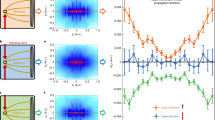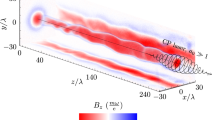Abstract
Huge magnetic fields are predicted1,2,3,4 to exist in the high-density region of plasmas produced during intense laser–matter interaction, near the critical-density surface where most laser absorption occurs, but until now these fields have never been measured. By using pulses focused to extreme intensities to investigate laser–plasma interactions5, we have been able to record the highest magnetic fields ever produced in a laboratory – over 340 megagauss – by polarimetry measurements of self-generated laser harmonics.
Similar content being viewed by others
Main
Because harmonics of the laser are generated at the critical-density surface and subsequently propagate isotropically out of the dense region6, we have found that measuring the final polarization of these harmonics is a powerful way to find out the magnitude of the magnetic fields through which they travel. The use of self-generated laser harmonics is particularly convenient because these are produced at precisely the same time as the magnetic fields are generated and propagate so that their k vectors are perpendicular to azimuthal magnetic fields in the plasma –– which greatly simplifies data interpretation. In our experiments, we use the propagation properties of lower-order harmonics (that is, the third, fourth and fifth harmonics).
These results were obtained with the Vulcan laser system (wavelength 1.054 µm, pulse energy up to 90 J, pulse duration about 1 picosecond). The beam was p-polarized and focused to a maximum intensity of 9 × 1019 W cm−2 onto a thin solid target (0.1–1.0 mm). The polarization components of the emitted laser harmonics were measured by using high-dynamic-range, charge-coupled-device arrays as detectors.
When an electromagnetic wave propagates in a magnetized plasma with its k vector perpendicular to B, the extraordinary wave (x-wave; that is, with an electric field vector perpendicular to the magnetic field) can experience cut-offs and resonances (Fig. 1a). Cut-offs occur when the plasma index of refraction is equal to zero, and resonances when the index approaches infinity. The x-wave is reflected when it encounters a cut-off and is absorbed in a resonance. For example, the cut-offs for the fifth, fourth and third harmonics occur at 460, 340 and 220 megagauss, respectively, for a density of ne = 2.4 × 1021 cm−3 (the relativistically corrected critical density). Resonances occur at higher magnetic fields than cut-offs. The ordinary (o) wave (with E parallel to B) is unaffected by the magnetic field –– implying that if a field larger than the cut-off field exists in the plasma, then only the ordinary wave is able to propagate to the detector and therefore is the only one observable.
This is what we find for the highest-intensity shots. Figure 1b shows the ratio of p-component (x-wave) to total emission (x-wave plus o-wave) for both the third and fourth harmonics for various incident laser intensities. At high intensities, the x-wave cut-offs are definitely observed, implying the existence of a minimum magnetic field of 340 megagauss in the plasma; no cut-offs were seen for the fifth harmonic. This indicates that the peak magnetic field is below 460 and above 340 megagauss at intensities of about 9 × 1019 W cm−2. Such fields are more than an order of magnitude larger than any previously observed in the laboratory7,8,9. These cut-offs were consistently reproducible in our experiments –– but only at the highest laser intensities.
The magnitude of the magnetic fields generated in this way could soon approach those needed for testing astrophysical models of neutron stars and white dwarfs10.
References
Wilks, S. C. et al. Phys. Rev. Lett. 69, 1383–1386 (1992).
Pukhov, A. & Meyer-ter-Vehn, J. Phys. Rev. Lett. 76, 3975–3978 (1996).
Mason, R. J. & Tabak, M. Phys. Rev. Lett. 80, 524–527 (1998).
Sudan, R. Phys. Rev. Lett. 70, 3075–3078 (1993).
Perry, M. D. & Mourou, G. Science 264, 917–924 (1994).
Norreys, P. A. et al. Phys. Rev. Lett. 76, 1832–1835 (1996).
Borghesi, M. et al. Phys. Rev. Lett. 80, 5137–5140 (1998).
Tatarakis, M. et al. Phys. Rev. Lett. 81, 999–1002 (1998).
Clark, E. L. et al. Phys. Rev. Lett. 84, 670–673 (2000).
Lai, D. & Salpeter, E. E. Astrophys. J. 491, 270–285 (1997).
Author information
Authors and Affiliations
Corresponding author
Rights and permissions
About this article
Cite this article
Tatarakis, M., Watts, I., Beg, F. et al. Measuring huge magnetic fields. Nature 415, 280 (2002). https://doi.org/10.1038/415280a
Issue Date:
DOI: https://doi.org/10.1038/415280a
This article is cited by
-
Generation of intense magnetic wakes by relativistic laser pulses in plasma
Scientific Reports (2023)
-
Laser cluster interaction in ambient magnetic fields for accelerating electrons in two stages without external injection
Scientific Reports (2022)
-
Generation and collective interaction of giant magnetic dipoles in laser cluster plasma
Scientific Reports (2021)
-
Observation of magneto-electric rectification at non-relativistic intensities
Nature Communications (2020)
-
Optical Time-Resolved Diagnostics of Laser-Produced Plasmas
Journal of Fusion Energy (2019)
Comments
By submitting a comment you agree to abide by our Terms and Community Guidelines. If you find something abusive or that does not comply with our terms or guidelines please flag it as inappropriate.




